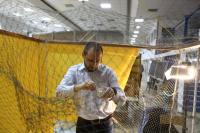Artificial Bee
When rapeseed growers found out what the scientists from Warsaw University of Technology were working on, they a planted low-growing species of rapeseed in order to help them, and kept their fingers crossed for completing the invention as soon as possible.
‘It is not an artificial bee’, Rafał Dalewski, PhD Eng., objects. He is the author of the idea and the Project Manager. ‘What we are doing is an automatic system for pollinating plants. That is something completely different’, he explains. However, how can an amateur not associate the concept with an artificial bee, if the invention of scientists from the Warsaw University of Technology will pollinate plants instead of bees? Even its name—B-droid—brings them to mind.
Is the automatic pollinator just a scientists’ whim? On the contrary. This device could be in demand in many countries. Bees have been dying out en masse all over the world for many years now. Why is this happening? Nobody knows. We blame many factors, such as environmental pollution, fungi, viruses and parasites, to name just a few. What is worse, nobody knows how to prevent it. In the meantime, the consequence of bees dying out is an ever-growing problem. It is estimated that over one third of crops and as much as 90% of wild plants must be pollinated, and it is the bee which is the main pollinating insect. In some areas, farmers must already bring insects over long distances, which significantly increases the costs of food production. ‘The question is, do we have an alternative here? What will we do if the effectiveness of food production drops to such a level that it will force us to think about how to feed people?’, Doctor Dalewski wonders.
He works with a team to find an alternative to bees. That is where the idea for the automatic plant pollinator originated. Such a development requires the co-operation of specialists in various fields, such as aerodynamics, robotics, electronics, and mechanics. Someone must construct and program the device. We also need biologists—how can a group of engineers know how real insects behave? The biggest challenge was not the pollination itself (which turned out to be quite simple), but... recognising flowers and checking if they are ready to be pollinated. ‘The most important thing we are preparing is the software for colour and shape recognition and controlling a robot, so that the device will be able to recognise and adjust itself to different flowers’, the project’s author says.
The B-droid has eyes, which are two small cameras that recognise flowers and enable spatial orientation. At the very heart of it is a computer, or two of them, to be precise. A small computer mounted on the „bee” radios the data of all objects in sight to the central computer. The big computer analyses the data and responds with signals navigating the devices. The artificial bee does not need a person with a controller to navigate, as the robot itself knows where it is supposed to go.
The scientists are preparing two versions of the machine—one that can drive and one that can fly. As for now, a prototype of the driving machine is ready. It does not look like a real bee at all. The pollinator has been mounted on a mobile platform. When one sector has been pollinated, the engine starts and the platform moves on. This machine is suitable for pollinating large planted areas. The prototype has already undergone a successful baptism of fire on a rapeseed field. A farmer deliberately planted low-growing rapeseed for the purposes of the test so that a lower platform could be used.
The engineers are still working on the flying pollinator. It resembles an insect a little bit more—it has a barrel-like shape, but it is several times larger than a real bee. Both machines should be ready as demonstrators in a year’s time. The creators of the B-droid have not thought about one thing, though—how to produce honey.
Description of the project comes from the catalogue of the National Research and Development Centre "Innovation for Development".








